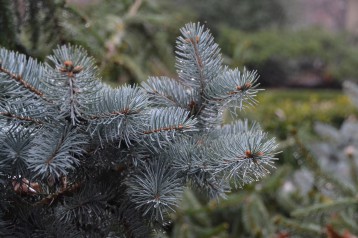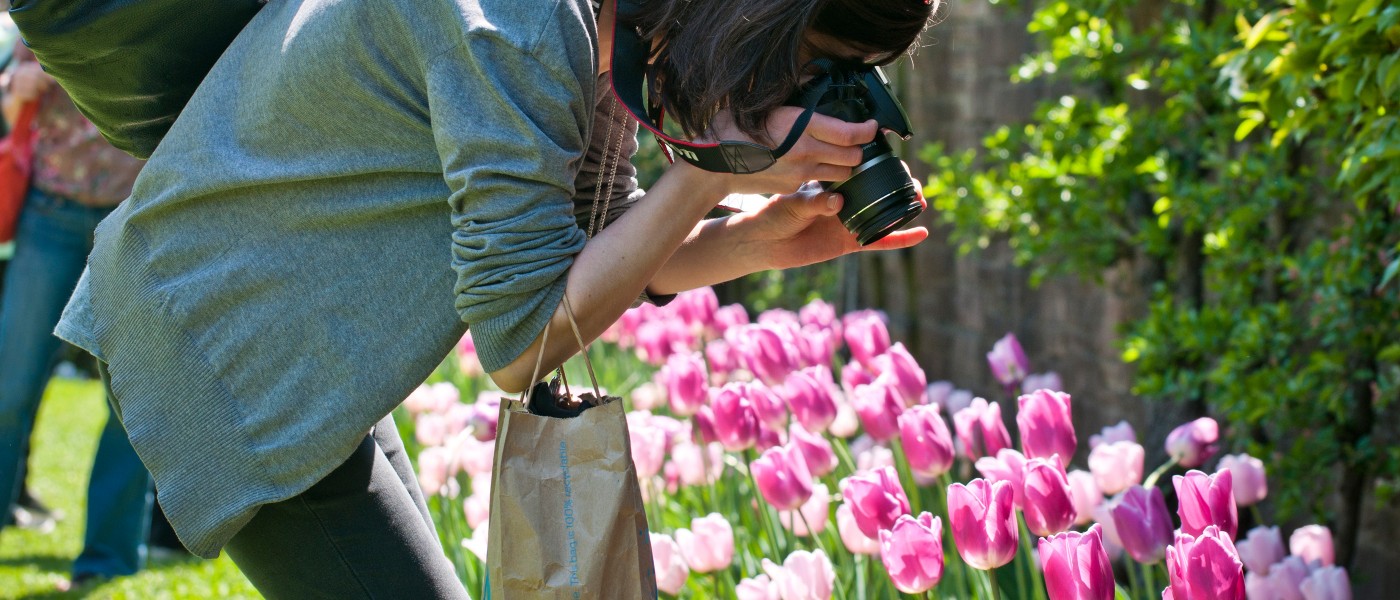Plants in Bloom
December highlights

Golden Shrimp Plant
The gently curved flower clusters of Pachystachys lutea resemble a shrimp (if you squint a bit).
Pachystachys lutea (golden shrimp plant) in the Tropical Pavilion. Photo: Michael Stewart.

Christmas-Rose
The first of the hellebores to bloom is the Christmas-rose, so-called because it blooms around Christmastime and has a flower arrangement that looks similar to that of a rose.
Helleborus niger ‘Hgc Josef Lemper’ (Christmas-rose) blooming near the Flatbush Avenue entrance. Photo: Lee Patrick.

English Holly
This is the holly species most commonly associated with Christmas, especially in England, where it is one of the few native evergreen plants. Its bright red berries ripen in winter and provide food for birds.
Ilex aquifolium ‘Balkans’ (English holly) in the Shakespeare Garden. Photo: Michael Stewart.

Cedar of Lebanon
Though many North American conifers were called “cedar,” there are only four true cedar species. Native to the mountains of Turkey, Syria, and Lebanon, this true cedar is under severe threat from climate change as its range shifts upward.
Cedrus libani (cedar of Lebanon) in the Plant Family Collection. Photo: Michael Stewart.

Winterberry
The lovely berries of this native holly relative persist through winter, sometimes spring. These fruits are a welcome food for hungry birds as the weather cools and other options get scarce.
Ilex verticillata ‘Winter Gold’ (winterberry ) in the Discovery Garden. Photo: Michael Stewart.

Beautyberry
This shrub’s iridescent clusters of berries persist after its leaves drop, providing winter sustenance for many species of birds.
Callicarpa dichotoma ‘Early Amethyst’ (beautyberry) in the Plant Family Collection. Photo: Blanca Begert.

Paperbush Buds
This shrub’s downy, golden-gray buds hang in tight clusters from its bare branches. The buds are protected by fine hairs that give them a shimmery quality so they sparkle in the winter sun.
Edgeworthia chrysantha (paperbush) in the Shakespeare Garden. Photo: Elizabeth Peters.

Tiger Orchid
This enormous tropical orchid weighs over 300 pounds and rarely blooms—but when it does, it’s magnificent, with hundreds of yellow-and-brown-spotted blossoms. Even in its native habitat in Southeast Asia, the species blooms infrequently, reportedly once every two to four years.
Grammatophyllum speciosum (tiger orchid) in the Aquatic House. Photo: Michael Stewart.

Papaya Fruit
Known as pawpaw in Jamaica and Trinidad and Tobago (different from the American pawpaw), green, unripe papaya is used in chutneys, salads, relishes, and pawpaw balls—a gelatinous, sugar-dusted dessert.
Carica papaya (papaya) in the Tropical Pavilion. Photo: Michael Stewart.

Deodar Cedar
The deodar cedar, native to the Himalayas, is the national tree of Pakistan. It is monoecious—both male and female cones grow on the same tree—with drooping, graceful branches.
Cedrus deodara (deodar cedar) in the Plant Family Collection. Photo: Lee Patrick.

Prostrate Blue Spruce
This low-growing spruce is named for its spreading habit and attractive silver-blue needles. Gardeners appreciate it as an evergreen groundcover that is well-suited to dry and urban environments.
Picea pungens (Glauca Group) ‘Glauca Prostrata’ (prostrate blue spruce) in the Fragrance Garden. Photo: Lee Patrick.

Green Hawthorn
Native to the southeastern United States, this pretty understory tree produces small orange-red fruits in the fall.
Crataegus viridis ‘Winter King’ (green hawthorn) in the Plant Family Collection. Photo: Lee Patrick.

Common Myrtle
This evergreen shrub produces fragrant white flowers that are followed by purplish-black berries. The berries are edible—but not particularly tasty.
Myrtus communis (common myrtle) in the Warm Temperate Pavilion. Photo: Michael Stewart.

Oak-Leaved Hydrangea
In fall, the oak-shaped leaves of Hydrangea quercifolia produce vivid shades of purple, red, and gold.
Hydrangea quercifolia ‘Snow Queen’ (oak-leaved hydrangea) on Magnolia Plaza. Photo: Michael Stewart.

Malaysian-Orchid
Medinilla multiflora is commonly known as the Malaysian-orchid, though it is neither a true orchid nor native to Malaysia. Native to the Philippines, this species (like many orchids) is an epiphyte: an “air plant” that grows on top of other plants, rather than putting roots in the ground.
Medinilla multiflora (Malaysian-orchid) in the Tropical Pavilion. Photo: Michael Stewart.

Japanese Mahonia
This evergreen shrub is actually native to China, though it’s commonly grown in Japan. Its sweet-smelling yellow flowers bloom from late autumn to early spring.
Mahonia japonica (Japanese mahonia) in the Osborne Garden. Photo: Lee Patrick.

Fragrant Olive
The lovely, enveloping fragrance of this unassuming shrub helps make the Warm Temperate Pavilion a winter highlight at Brooklyn Botanic Garden.
Osmanthus fragrans (fragrant olive) in the Warm Temperate Pavilion. Photo: Michael Stewart.

Bird-of-Paradise
It’s hard to miss this iconic plant, whose flowers resemble a bright bird in flight. In its native South Africa, when endemic birds drink the nectar of Strelitzia reginae, its petals open to shower their feet with pollen.
Strelitzia reginae (bird-of-paradise) in the Warm Temperate Pavilion. Photo: Michael Stewart.

Dogwood [Baton Rouge]
The bare, bright crimson stems of many dogwood cultivars provide vibrant color in fall and winter.
Cornus alba Baton Rouge = ‘Minbat’ (PBR) (dogwood) in the Water Garden. Photo: Blanca Begert.

Autumn-Flowering Cherry
‘Jugatsu-zakura’ begins blooming around October, continues sporadically into December, and finishes in the spring with a last burst coinciding with new foliage.
Prunus × subhirtella ‘Jugatsu-zakura’ (flowering cherry) in the Cherry Cultivars Area. Photo: Elizabeth Peters.

Camellia
Most camellias begin to bloom in late winter and continue through early spring (though there are fall-blooming cultivars, too), often coinciding with Lunar New Year celebrations.
Camellia ‘Winter’s Star’ (camellia) in the Japanese Hill-and-Pond Garden. Photo: Michael Stewart.

Chinese Juniper
Chinese juniper is an evergreen with scaly scented needles and brown bark that peels off in strips. Relatively salt-tolerant, it can thrive near roads and driveways.
Juniperus chinensis ‘Robust Green’ (Chinese juniper) in the Rock Garden. Photo: Michael Stewart.

Sasanqua Camellia
This fall- to winter-flowering camellia is a favorite in the Bonsai Museum, bearing full-size flowers on its miniaturized form.
Camellia sasanqua (sasanqua camellia) in the Bonsai Museum. Photo: Blanca Begert.

Japanese Forest Grass
This gracefully arching pale-green grass turns pretty colors of gold and orange in the fall, offering multi-season color and texture.
Hakonechloa macra (Japanese forest grass) on Lily Pool Terrace. Photo: Lee Patrick.

Crabapple Fruits
The edible fruits from crabapple trees resemble tiny apples, though they’re much more tart. Birds, especially cedar waxwings, often feed on crabapples as the crop softens and ages.
Malus cultivar (crabapple) in the Plant Family Collection. Photo: Lee Patrick.

Orangeberry
Cultivated for its bright berries, various parts of this subtropical plant are used in traditional medicine in India, Bangladesh, and China, and it is the subject of a number of phytochemical investigations.
Glycosmis pentaphylla (orangeberry, also gin berry) with berries, in the Tropical Pavilion. Photo: Lee Patrick.

Himalayan Pine
The blue-green needles of the Himalayan pine are arranged in groupings called fascicles, each containing roughly five needles.
Pinus wallichiana (Himalayan pine) in the Plant Family Collection. Photo: Blanca Begert.

Cape Aloe
This evergreen succulent, native to South Africa and Lesotho, can grow up to 12 feet tall. It’s also known as “bitter aloe” in reference to its traditional medicinal use as a purgative.
Aloe ferox (cape aloe) in the Desert Pavilion. Photo: Blanca Begert.

Topal Holly
Longwood Garden’s cultivar of this naturally occurring holly hybrid, native to the southeast, was named “holly of the year” in 2022 and is hardy in more northern climes.
Ilex × attenuata ‘Longwood Gold’ (topal holly) near the Visitor Center. Photo: Lee Patrick.

Paintbrush
Endemic to South Africa, this bulb gets its common name from the cluster of white stamens tipped with yellow anthers.
Haemanthus albiflos (paintbrush) in the Warm Temperate Pavilion. Photo: Michael Stewart.

Brazilian-Plume
The Brazilian plume flower, native to Brazil’s Atlantic Forest region, is a shade-loving shrub with spectacular flared pink blooms.
Justicia carnea var. purpurea (Brazilian-plume) in the Tropical Pavilion. Photo: Lee Patrick.

Scarlet Skullcap
Most other species of skullcap have blue-toned blossoms and are pollinated by bees, but these bright red, upright, tubular flowers attract hummingbirds.
Scutellaria costaricana (scarlet skullcap), blooming like fireworks in the Tropical Pavilion. Photo: Lee Patrick.

Amazon Lily
Native to the Amazon basin, this bulb in the Amaryllis family bears large, fragrant, pure white flowers on slender stalks.
Eucharis × grandiflora (Amazon lily), blooming within the dense foliage of the Tropical Pavilion. Photo: Lee Patrick.

Rice-Paper Plant
The rice-paper plant, native to southern China and Taiwan, belongs to the ginseng family. The pith of its stems is used in Traditional Chinese Medicine, and to make rice paper veneer sheets and other products.
Tetrapanax papyrifer (rice-paper plant) in the Warm Temperate Pavilion. Photo: Michael Stewart.

Chinese Rain Bell
The leaves of this attractive subtropical plant are a source of indigo dye.
Strobilanthes cusia (Chinese rain bell) in the Warm Temperate Pavilion. Photo: Lee Patrick.

Common Camellia
This camellia cultivar is capable of surviving sub-zero temperatures in winter, adding a welcome pop of color with its broad red blossoms.
Camellia japonica ‘Korean Fire’ (common camellia) flowering near the Flatbush Avenue entrance. Photo: Lee Patrick.

Heavenly-Bamboo
Actually an evergreen shrub, not a bamboo, Nandina domestica produces bright red berries in autumn that persist through winter.
Nandina domestica (heavenly bamboo) in the Japanese Hill-and-Pond Garden. Photo: Michael Stewart.


